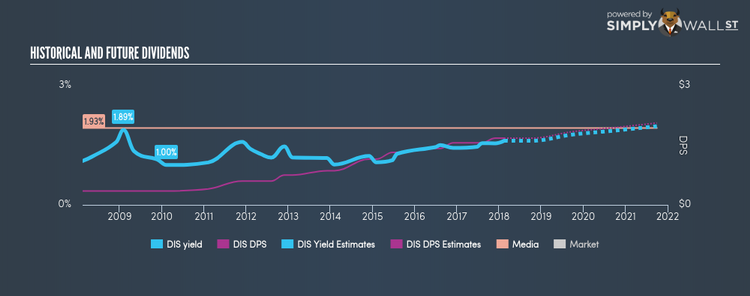Should The Walt Disney Company (NYSE:DIS) Be Part Of Your Dividend Portfolio?

Dividends play a key role in compounding returns over time and can form a large part of our portfolio return. The Walt Disney Company (NYSE:DIS) has returned to shareholders over the past 10 years, an average dividend yield of 1.00% annually. Let’s dig deeper into whether Walt Disney should have a place in your portfolio. Check out our latest analysis for Walt Disney
5 questions I ask before picking a dividend stock
If you are a dividend investor, you should always assess these five key metrics:
Is their annual yield among the top 25% of dividend payers?
Has its dividend been stable over the past (i.e. no missed payments or significant payout cuts)?
Has it increased its dividend per share amount over the past?
Can it afford to pay the current rate of dividends from its earnings?
Based on future earnings growth, will it be able to continue to payout dividend at the current rate?
How well does Walt Disney fit our criteria?
The current trailing twelve-month payout ratio for the stock is 22.96%, meaning the dividend is sufficiently covered by earnings. In the near future, analysts are predicting a payout ratio of 23.88%, leading to a dividend yield of around 1.73%. Furthermore, EPS should increase to $7.77. If there’s one type of stock you want to be reliable, it’s dividend stocks and their stable income-generating ability. In the case of DIS it has increased its DPS from $0.35 to $1.68 in the past 10 years. During this period it has not missed a payment, as one would expect for a company increasing its dividend. These are all positive signs of a great, reliable dividend stock. Compared to its peers, Walt Disney produces a yield of 1.61%, which is on the low-side for Media stocks.
Next Steps:
With these dividend metrics in mind, I definitely rank Walt Disney as a strong income stock, and is worth further research for anyone who considers dividends an important part of their portfolio strategy. Given that this is purely a dividend analysis, I recommend taking sufficient time to understand its core business and determine whether the company and its investment properties suit your overall goals. I’ve put together three fundamental factors you should further examine:
1. Future Outlook: What are well-informed industry analysts predicting for DIS’s future growth? Take a look at our free research report of analyst consensus for DIS’s outlook.
2. Valuation: What is DIS worth today? Even if the stock is a cash cow, it’s not worth an infinite price. The intrinsic value infographic in our free research report helps visualize whether DIS is currently mispriced by the market.
3. Other Dividend Rockstars: Are there better dividend payers with stronger fundamentals out there? Check out our free list of these great stocks here.
To help readers see pass the short term volatility of the financial market, we aim to bring you a long-term focused research analysis purely driven by fundamental data. Note that our analysis does not factor in the latest price sensitive company announcements.
The author is an independent contributor and at the time of publication had no position in the stocks mentioned.

